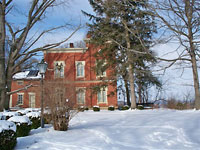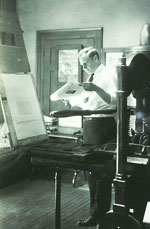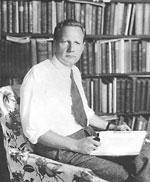A Passion for Paper
The Remarkable Life and Legacy of Dard Hunter By Karen Edwards Karen Edwards has been a freelance writer for Woman’s Day, Health, Eating Well, Entrepreneur, Antique Week, Early American Life, and Fine Books & Collections.
Not many tourists come to Mountain House, the tall, red brick home atop a bluff in Chillicothe, Ohio. Those who do visit—papermakers, fine press operators, book artists, and book collectors—come for a chance to glimpse the world of preeminent American papermaker and printer Dard Hunter. The Mountain House and Dard Hunter Studios preserve and carry on the work of this printing master, a man who could literally handcraft a book from start to finish.
“It’s become a cliché, so I hate to say it, but Dard was truly a Renaissance man,” said Cathleen Baker, paper conservator and the author of By His Own Labor: The Biography of Dard Hunter. “He was an incredible, multi-faceted man who thought outside the box.” Even with his laser-like focus on details, however, Hunter was a man who looked at things broadly, Baker continued. “He saw the connection of things.”
Setting Type
Dard Hunter was born William Joseph Hunter in 1883, in Steubenville, Ohio, but he acquired the nickname “Dard” at an early age. Dard Hunter’s grandson, Dard Hunter III, said the name came from his grandfather’s older brother Philip. “Everyone called the new baby ‘darling,’”—which Philip mispronounced as ‘Dard,’ said Hunter III. Over time, Dard not only became William’s nickname, but also the given name of both Hunter’s son and grandson.
Hunter’s first job was setting type for his father’s newspaper. By now, the family had moved to Chillicothe, and while setting type would be Hunter’s introduction to printing, he didn’t do it for long. His artistic ability had begun to emerge, and he was soon working as the paper’s staff artist. The job suited Hunter, but when his older brother began to travel the country with a magic act, the open road proved too strong a lure for the young Dard. He joined Philip on the road, entertaining crowds between his brother’s acts. One of the places the pair visited was Riverside, California, where they stayed at the New Glenwood Hotel—one of the first Arts and Crafts hotels in the country. Hunter was instantly smitten with the new style, and in June 1904, he applied for a position with Elbert Hubbard and the Roycrofters.
“He didn’t get the job, but he showed up at the compound anyway and was brought into the colony,” said Hunter III. Soon, Hunter was designing and making stained glass windows and creating title pages for the Roycroft Press in East Aurora, New York. He also provided all Roycroft products with a unified look—branding the group with a visual identity. While with the community, Hunter also fell in love with and married Edith Cornell, the Roycrofters’ concert pianist.
“I wouldn’t say my grandfather’s work was influenced by the Roycrofters or by Hubbard,” said his grandson. “He simply left his mark with them and moved on.” If anything can be credited with influencing Hunter’s work, said Hunter III, it was the Viennese artists, especially Josef Hoffmann and the Wiener Werkstätte. Hunter, in fact, was so taken by their work that he and Edith honeymooned in Vienna, and in 1910, he returned to the Austrian city for courses in lithography, book decoration, and letter design.
From Vienna, the Hunters moved to London, where Dard found work designing books at the Norfolk Studios. It was while living in London that Hunter discovered an exhibit on hand papermaking at the London Science Museum. He became fascinated by the papermaker’s tools—the moulds, watermarks, steel punches, and copper matrices. In the breadth of one visit, Hunter had found the work that would ultimately define his life.
Papermaking
“Papermaking was an area that no one in Hunter’s time was paying attention to,” said Baker. Hand papermaking in America had phased out in the 1890s. “If handmade paper was needed, it was imported from Europe,” said Hunter III. His grandfather set out to change that.
By 1913, the Hunters had moved to Marlborough, New York, where Hunter built a paper mill on the edge of Jew’s Creek, across the road from their home (now called the Gomez Mill House). Because Hunter was determined to make paper using seventeenth-century techniques, he depended on a water wheel to power the mill.











